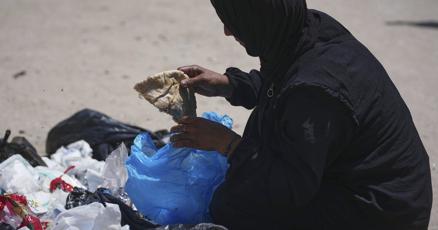In the shadow of collapsed buildings along Gaza City’s once-bustling streets, Sabreen Jouda and her four children comb through piles of garbage. Their fingers, blackened with dirt, carefully separate plastic wrappers containing morsels of discarded food from other refuse. This heartbreaking scene, increasingly common across Gaza, reveals the devastating human toll of what the United Nations has described as a hunger emergency bordering on famine.
“We haven’t received food aid in over two weeks,” Jouda explains, her voice barely audible as she instructs her children on what might be safe to salvage. “My children cry from hunger all night. What choice do I have?”
The humanitarian crisis in Gaza has reached catastrophic proportions in 2024, with the World Food Programme reporting that nearly 90% of Gaza’s 2.2 million residents face acute food insecurity. International aid organizations warn that children are now dying from malnutrition and dehydration—preventable conditions that have become death sentences in a territory where medical facilities lie in ruins.
Aid workers describe scenarios previously unimaginable in Gaza. “We’re seeing families boiling leaves and grass to create the illusion of a meal,” reports Sarah Khalidi, a field coordinator with International Relief Services. “Parents are going three to four days without eating so their children might have something, anything, to sustain them.”
The breakdown of food distribution networks has been particularly devastating in northern Gaza, where families like Jouda’s have been cut off from regular humanitarian corridors. The few aid trucks that do make it through face overwhelming crowds of desperate people, creating chaotic scenes that further complicate distribution efforts.
Canadian humanitarian organizations have intensified calls for protected corridors to deliver essential supplies. “What we’re witnessing isn’t just a food shortage—it’s a systematic collapse of all basic life necessities,” says Dr. Michael Levine of Canadian Emergency Response Initiative, who recently returned from assessing conditions in southern Gaza.
Economic analysts tracking the crisis note that Gaza’s food insecurity represents more than just supply chain disruptions. “We’re seeing the complete dissolution of normal market functions,” explains economic analyst Rania Abdelhamid. “Even when food is available, hyperinflation has put basic staples beyond reach for most families.”
The health consequences of prolonged malnutrition are already evident. At Al-Awda Hospital, operating at minimal capacity with limited supplies, Dr. Khalil Mahmoud reports treating dozens of children with severe acute malnutrition daily. “We’re seeing growth stunting, cognitive impairments, and immune system collapse—conditions that will affect an entire generation for decades to come,” he explains.
International political pressure has intensified for expanded humanitarian access, with the UN Security Council issuing increasingly urgent statements. Yet on the ground, aid workers report that bureaucratic obstacles and security concerns continue to impede delivery of life-saving supplies.
For Jouda and countless families like hers, international diplomacy feels distant from their immediate reality. As night falls, she gathers her children and their meager findings—half-rotted vegetables and discarded bread crusts—to return to their temporary shelter, a single room in a damaged building housing three displaced families.
“Tomorrow we will search again,” she says, her gaze fixed on her youngest child, whose ribs protrude visibly beneath his thin shirt. “What else can we do?”
As Gaza’s hunger crisis deepens in 2024, the fundamental question remains: In a world of abundance, how have we allowed children to scavenge through garbage for sustenance while diplomatic solutions remain elusive?










